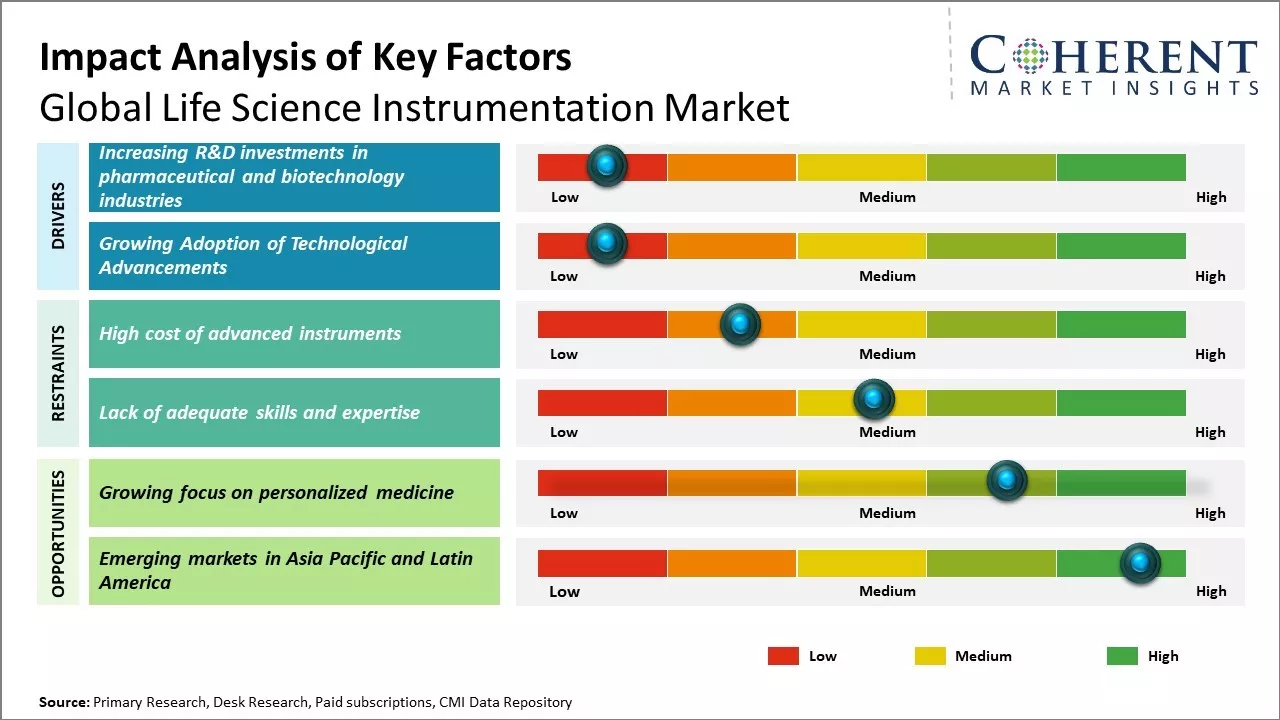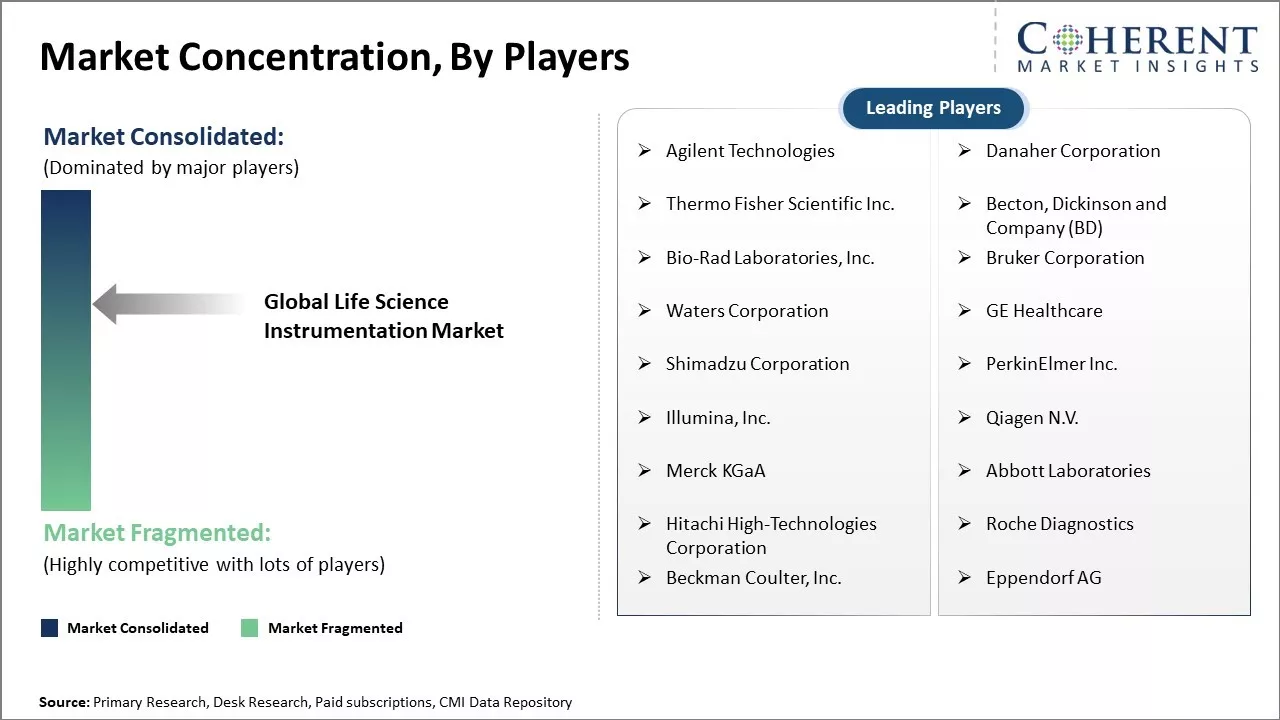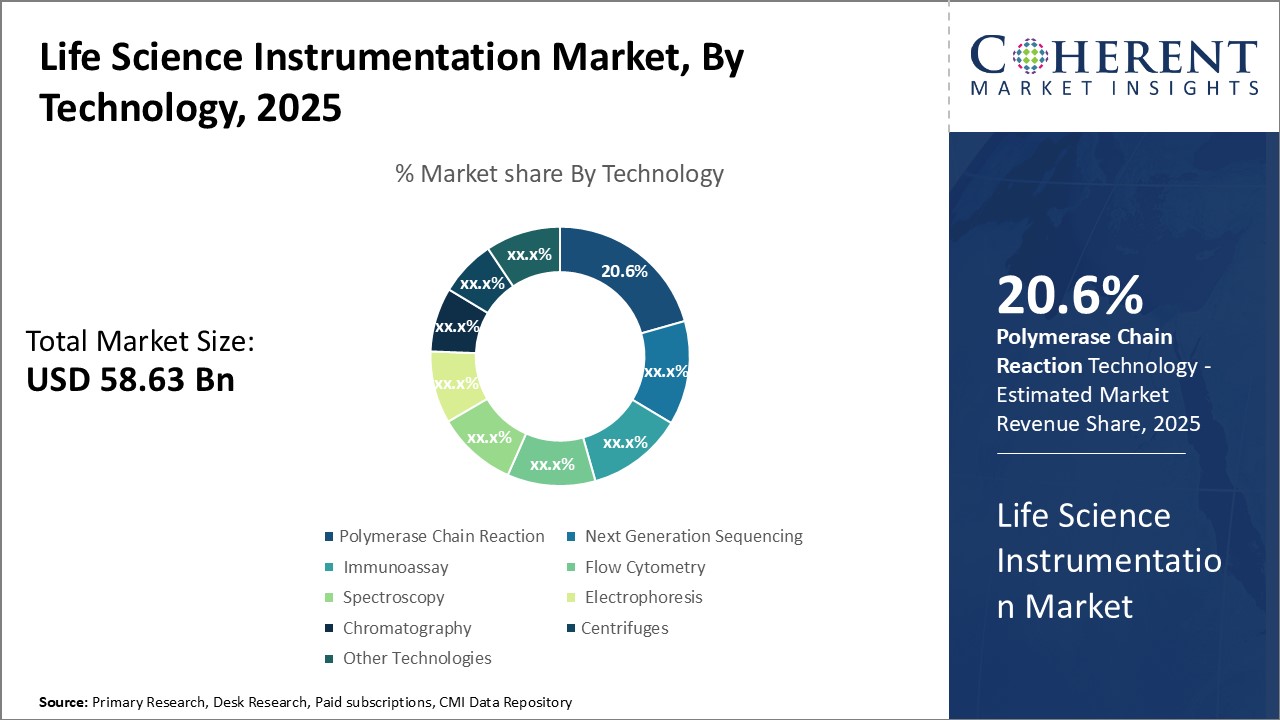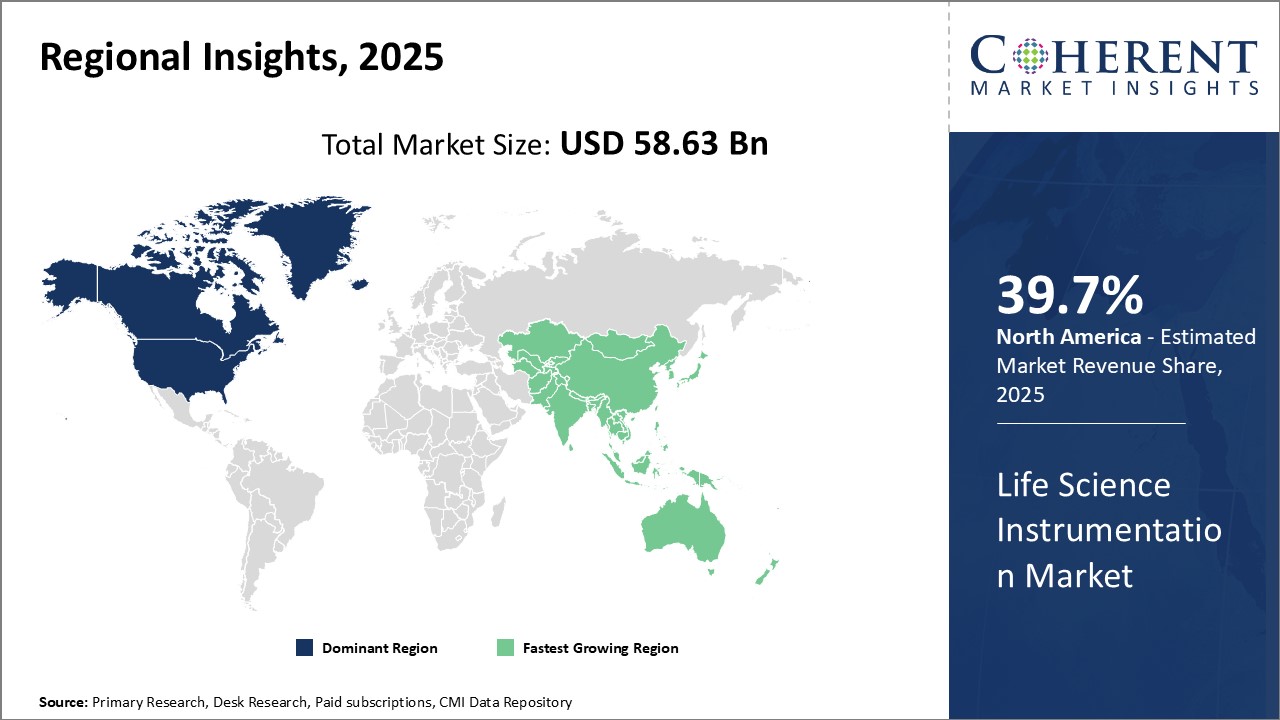The Global Life Science Instrumentation Market is estimated to be valued at USD 58.63 Bn in 2025 and is expected to reach USD 90.58 Bn by 2032, exhibiting a compound annual growth rate (CAGR) of 6.4% from 2025 to 2032.

Discover market dynamics shaping the industry: Request sample copy
With rising investments in research and development of novel drugs, there is an increasing demand for technologically advanced life science instrumentation. Growing initiatives by governments worldwide to promote precision medicine is another factor boosting the adoption of modern life science instrumentation. Pharmaceutical and biotechnology industries are increasingly investing in advanced technologies like machine learning and artificial intelligence to accelerate drug discovery processes. This is creating favorable environment for players in this market with demand for high performance and innovative life science instrumentation expected to rise substantially in the coming years.
Growth in Pharmaceutical R&D Spending and Discovery Research
One of the major drivers fueling the growth of the global life science instrumentation market is the increase in spending on pharmaceutical R&D by biopharmaceutical companies around the world. A number of leading pharmaceutical companies are heavily investing in developing innovative drugs for various therapeutic areas such as oncology, cardiology and immunology. Life science instrumentation tools play a crucial role in enabling discovery research activities by providing accurate analysis, virtual screening and high-throughput testing capabilities. With rising investments dedicated for discovery, these tools have become indispensable for target validation, cell line development, assay optimization and screening large compound libraries to identify potential drug candidates. As per some estimates, the global pharmaceutical R&D expenditure increased from around US$160 billion in 2015 to over US$190 billion in 2020. In the coming years, spending levels are expected to rise further with large players expanding their pipelines and production capacity. Oncology alone accounts for over 25% of the total money invested in R&D activities. Many big pharmaceutical corporations have set aside multi-billion-dollar budgets for research specifically focusing on cancer treatment in a bid to come up with innovative targeted therapies and personalized medicines. This exponential increase in financial allocation for developing breakthrough new drugs will definitely propel the demand for cutting-edge life science instrumentation required by both industry and academic research organizations. For Instance, as indicated in an article from the U.K. Parliament in October 2022, the U.K.'s total expenditure on R&D for the year amounted to EUR 37.1 billion. Additionally, according to OECD data, Bulgaria had the highest pharmaceutical spending as a percentage of GDP in 2021, allocating approximately 32.4% to pharmaceuticals. This increased investment in pharmaceutical R&D is anticipated to drive market expansion in the coming years.

Get actionable strategies to beat competition: Request sample copy
Growing Adoption of Technological Advancements
Another important factor contributing to the positive outlook of the life science instrumentation market is the rising adoption of new technologies across various application areas. Continuous innovation is taking place in the development of instruments that are more efficient, higher-throughput, miniaturized and capable of multi-modal analysis. Emerging technologies such as automation, machine learning, artificial intelligence, robotics, next-generation sequencing and lab-on-a-chip are tremendously enhancing the capabilities of existing instruments. Transition to automated platforms is helping streamline complex workflow in spaces like proteomics, genomics and cell biology research. Use of robotics is minimizing manual errors and improving reproducibility. Lab automation is drastically reducing processing time and sample volumes required. Life science researchers and companies are rapidly embracing these technological breakthroughs to refine older techniques, develop novel methods and elevate the pace of scientific discovery. Affordable prices of some advanced instruments are also encouraging their wider acceptance. For instance, DNA sequencing machines have become more widespread with advances lowering costs 100 to 1,000-fold compared to previous versions
Key Takeaways of Analyst:
The life science instrumentation market is estimated to see steady growth over the next few years driven by increasing R&D investments in pharmaceutical and biotechnology industries. Advancing proteomics and genomics research will considerably drive the demand for high-throughput screening instruments and spectroscopy technologies. North America dominated the market in the past owing to presence of major players and focus on precision medicine. However, Asia Pacific is projected to be the fastest growing region owing to expanding biopharma industry and large patient pool in China and India.
The increasing prevalence of lifestyle diseases and chronic conditions will augment the need for development of novel therapeutics, thereby stimulating sales of analytical and separation instruments. Industry-academia collaboration in life science research also provides an opportunity to introduce new instrument categories. On the flip side, high costs of advanced life science instrumentation could hamper widespread adoption, especially in price-sensitive developing regions. Intense competition among existing players also limits the scope for extensive profitability. Continued consolidation activities across the life science sector poses a threat to smaller individual instrument manufacturers. Strict regulatory requirements pertaining to approval of new life science instruments also slow down product commercialization. Overall, the life science instrumentation market is expected to witness steady growth over the next decade powered by increasing R&D spending globally.
Market Challenges: High cost of advanced instruments
High cost of advanced life science instruments is one of the major factors restraining the growth of the global life science instrumentation market. The research and development in life science instrumentation requires huge capital investments in advanced technologies. Many benchtops analytical instruments use highly sophisticated technologies like mass spectrometry, spectroscopy, sequencing etc. which pushes the initial costs of these instruments upwards of hundreds of thousands to millions of dollars. Moreover, maintaining precision and accuracy of these instruments over long term requires frequent calibration, validation and upgrade of components which leads to additional operational costs. Several research institutions and academia in developing nations struggle to procure and maintain such expensive instrumentation due to budgetary constraints. As per data from UNESCO Institute for Statistics (UIS), the average expenditure on research and development (R&D) as a percentage of GDP was only 1.7% for low-income countries compared to over 2.4% for high-income countries in 2021. Limited funding for research hampers wider adoption of new life science technologies especially in developing regions of the world. This acts as a barrier for life science companies looking to tap emerging markets.
Market Opportunities: Growing focus on personalized medicine
Growing focus on personalized medicine offers a huge opportunity for the global life science instrumentation market. Personalized medicine takes into account individual variability in genes, environment and lifestyle for each person. It allows doctors or clinicians to select appropriate preventive or therapeutic interventions tailored to the individual. With developments in fields such as pharmacogenomics and molecular diagnostics, it has become possible to analyze an individual's genetic makeup and fine-tune medical treatment based on the person's likely response to drugs or susceptibility to diseases. This shifts the approach from a 'one-size-fits-all' to a tailored treatment for each individual.
Life science instrumentation that can help enable personalized medicine by enabling key aspects such as high-throughput screening, high-sensitivity detection, accurate sample analysis and data processing at the molecular level are poised to grow. For example, next-generation sequencing instruments can rapidly decode whole genomes and detect genetic variations. Such insights allow scientists to better understand how genetic differences influence disease risk, medication response and care management strategies for each person. Mass spectrometry instruments can analyze biological samples to detect protein and metabolite signatures that can serve as biomarkers for diseases or treatment response. Imaging instruments with advanced capabilities help clinicians gain deeper insights into diseases at the molecular level within tissues and cells.

Discover high revenue pocket segments and roadmap to it: Request sample copy
Insights, By Technology: Advancing Genomic Research Boosts PCR Dominance
In terms of Technology, the Polymerase Chain Reaction (PCR) segment is estimated to hold the highest share of 20.6% in 2025 owing to its widespread usage in genomic research and diagnostics. PCR has transformed molecular biology since its invention in 1983, allowing scientists to amplify specific DNA sequences which has powered key advances like genome sequencing. Ever declining costs of PCR instruments and consumables have also boosted their accessibility. Moreover, continuous technical improvements like real-time quantitative PCR and digital PCR have expanded the range of PCR applications. Recently, digital PCR has seen increased adoption for detecting minimal residual diseases and rare mutations as it provides more accurate quantification of nucleic acids without standards. Widespread ability to perform multiplex PCR has augmented its utility in genomic and genetic studies involving large numbers of targets. Further developments towards quantitative PCR for point-of-care pathogen detection would aid its growth prospects. Rising genome research activities aimed at understanding the molecular basis of diseases and developing personalized therapies has sustainably driven the demand for high throughput PCR systems.
Insights, By End User: Pharma R&D Growth Steers Immunoassay Equipment Demand
In terms of End User, the Pharmaceutical and Biotechnology Companies segment is estimated to hold the highest share of 35.5% in 2025 owing to their substantive investment in R&D requiring advanced life science tools. Immunoassay technology has emerged as an important segment in this regard due to wide applicability in drug development, discovery and production processes. Being a highly sensitive and specific technique, immunoassays are extensively used by pharma companies right from the early stages of drug candidate screening and selection to monitoring drug levels during clinical trials. Areas such as toxicology testing, therapeutic drug monitoring and assessing bio similarity heavily rely on various immunoassay modalities like enzyme-linked immunosorbent assay (ELISA), radioimmunoassay (RIA), fluorescence immunoassay etc. Complimenting this is the growing need for personalized medicines which has boosted research analyzing genetic and protein biomarkers using immunoassay platforms. Moreover, stringent regulatory norms have increased the pharma industry's dependence on immunoassays for ensuring drug quality, safety and efficacy. Hence, as pharma research expenditures continue escalating globally to offset patent cliff losses, the demand for state-of-the-art immunoassay solutions from leading manufacturers is projected to rise accordingly.
Insights, By Application: Diagnostics Domination Catalyzes Spectroscopy Sales
Among applications, the Clinical & Diagnostic segment is estimated to hold the highest share of 50.10 % in 2025 due to the widespread need for spectroscopic techniques in hospitals and labs. Technologies like absorption spectroscopy (UV-Vis), fluorescence spectroscopy, vibrational spectroscopy (IR and Raman) have become indispensable diagnostic tools. For instance, UV-Vis spectrophotometry finds extensive applications for therapeutic drug monitoring, analyzing hemoglobin levels and screening newborns for metabolic disorders. Similarly, IR spectroscopy enables rapid identification of pathogens and diseases via fingerprinting of biological samples. Fluorescence spectroscopy aids disease diagnosis by detecting the signatures of biomarkers, and allowing imaging of tissues. Rising burden of chronic diseases and increasing insurance coverage has boosted diagnostic testing volumes globally. Further, focus on earlier disease detection and prevention has augmented demand for lab-based diagnostic analyses employing various spectroscopic platforms. Portable instruments capable of point-of-care testing are gaining importance as well owing to benefits like faster diagnosis and treatment. Thus, advancements towards miniaturization and microfluidics-based spectroscopic devices would further catalyze their usage in clinical settings.

Need a Different Region or Segment? Customize now
North America has long dominated the global life science instrumentation market and is estimated to hold the largest share of 39.2 % in 2025. This can be attributed to the region's heavy investments in biomedical research and presence of top pharmaceutical and biotech companies. The U.S. alone accounts for over 39.7% of the research spending globally and has the highest healthcare expenditure. Most of the major life science instrumentation OEMs like Thermo Fisher Scientific, Danaher Corporation, Agilent Technologies, and Waters Corporation are headquartered in the U.S., giving the region an industry presence edge. North American life science instrumentation also benefits from the localized manufacturing and supply chains of these companies.
The Asia Pacific region has emerged as the fastest growing market for life science instrumentation in recent years. Countries like China, Japan, South Korea, India and others are increasingly investing in healthcare and biomedical infrastructure. This has created a surge in demand for advanced life science research tools and analytical equipment within the region. China remains the major growth driver within Asia Pacific as its pharmaceutical industry expands to fulfill the large healthcare needs of its population. As Chinese pharmaceutical companies develop capabilities in drug discovery and manufacturing, they are procuring more laboratory instruments and automation solutions. Asia Pacific life science instruments also see increased adoption in tandem with rising contract research and manufacturing activities centered in India, Singapore and other Southeast Asian nations. Furthermore, exports of life science instruments from North America and Europe into this region have risen significantly.
Life Science Instrumentation Market Report Coverage
| Report Coverage | Details | ||
|---|---|---|---|
| Base Year: | 2024 | Market Size in 2025: | USD 58.63 Bn |
| Historical Data for: | 2020 To 2024 | Forecast Period: | 2025 To 2032 |
| Forecast Period 2025 to 2032 CAGR: | 6.4% | 2032 Value Projection: | USD 90.58 Bn |
| Geographies covered: |
|
||
| Segments covered: |
|
||
| Companies covered: |
Agilent Technologies, Danaher Corporation, Thermo Fisher Scientific Inc., Becton, Dickinson and Company (BD), Bio-Rad Laboratories, Inc., Bruker Corporation, Waters Corporation, GE Healthcare, Shimadzu Corporation, PerkinElmer Inc., Illumina, Inc., Qiagen N.V., Merck KGaA, Abbott Laboratories, Hitachi High-Technologies Corporation, Roche Diagnostics, Beckman Coulter, Inc., and Eppendorf AG |
||
| Growth Drivers: |
|
||
| Restraints & Challenges: |
|
||
Uncover macros and micros vetted on 75+ parameters: Get instant access to report
*Definition: The Global Life Science Instrumentation Market consists of instruments used across various life science industries like biotechnology, pharmaceutical, diagnostic and many more. This includes analytical instruments like chromatography, spectroscopy, PCR and sequencing equipment used for purification, identification and analysis. It also contains lab equipment like centrifuges, incubators, sterilizers used majorly in research activities. The Global Life Science Instrumentation Market aims to advance life science research by providing innovative, high quality and precise analytical tools and lab equipment enabling faster development of drugs, diagnostics and other applications.
Share
Share
About Author
Komal Dighe is a Management Consultant with over 8 years of experience in market research and consulting. She excels in managing and delivering high-quality insights and solutions in Health-tech Consulting reports. Her expertise encompasses conducting both primary and secondary research, effectively addressing client requirements, and excelling in market estimation and forecast. Her comprehensive approach ensures that clients receive thorough and accurate analyses, enabling them to make informed decisions and capitalize on market opportunities.
Missing comfort of reading report in your local language? Find your preferred language :
Transform your Strategy with Exclusive Trending Reports :
Frequently Asked Questions
Joining thousands of companies around the world committed to making the Excellent Business Solutions.
View All Our Clients
US Reciprocal Tax Impact Analysis On Life Science Instrumentation Market
Stay updated on tariff changes with expert insights and timely information